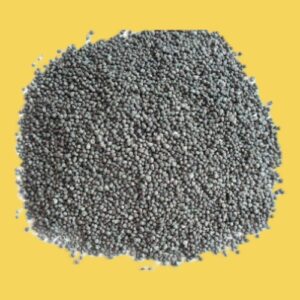Phosphorus is an essential plant nutrient. Soil should be rich in phosphorus for the proper growth and development of crops. However, if the soil is deficient in Phosphorus, application of phosphorus is recommended to farmers. Many types of Phosphate fertilizers are available in the market. Among them, the most common and widely used fertilizer is Single super Phosphate(SSP).
Single Super Phosphate contains only one nutrient i.e. Phosphorus. So, it is a simple fertilizer having the chemical formula Ca(H2PO4)2.2H2O (Monocalcium Phosphate Dihydrate). In SSP, the phosphorus is in the form of P205 and contains 16% P2O5. Besides phosphorus, Single Super Phosphate also contains some amount of Sulfur, Calcium etc. So, It can also be beneficial for Sulfur deficient soil.
It is the first commercial mineral fertilizer that led to the establishment of the plant nutrient industry. However, it is now replaced by Triple Super Phosphate (TSP). These types of fertilizers can be used in different types of soil and are generally water-soluble. Mostly, Single Super Phosphate is applied as a basal dose and it can be blended with other fertilizers like DAP before application. Single Super Phosphate is mostly manufactured from rock phosphate.
Properties of Single Super Phosphate

1. Single Super Phosphate is a Monocalcium phosphate dihydrate i.e. Ca(H2PO4)2.2H2O
2. It contains 16% P2O5.
3. The Sulfur and Calcium content in Single Super Phosphate is 10-12% and 19-22% respectively.
4. It consists of about 85% water-soluble phosphorus.
5. It is slightly hygroscopic.
6. It is a water-soluble phosphate fertilizer.
7. The residual effect of phosphate fertilizer is acidic.
Manufacturing
•Raw materials
The raw materials required for the manufacturing of SSP are:-
✓Rock Phosphate
Rock phosphate deposits are the major source of phosphorus and have 14-35% phosphorus content. Rock phosphate is rich in mineral fluorapatite (Ca5(PO4)3F).
✓Sulphuric acid
•Process
In the manufacturing process, the insoluble phosphate present in rock phosphate is converted into soluble phosphate by reacting it with Sulphuric acid. The decomposition of rock phosphate with sulphuric acid produces different kinds of phosphate compounds, including Single Super Phosphate, which is one of the most important fertilizers.
The reaction involved in the manufacture of Single Super Phosphate is as:-
2Ca5(PO4)3F + 7H2SO4 + 3H2O → 7CaSO4 + 3Ca(H2PO4)2 . H2O + 2HF
The manufacturing process involves the following distinct steps:-
1.Blending and grinding of Rock Phosphate
Depending upon its origin, the mineral content of phosphate rock varies. The phosphate rocks are mixed in the blending plant to produce a product of 15% phosphorus concentration. The particle size is reduced by passing the mixture through a hammer mill which converts particle size to 0.5 cm or less. The coarsely ground rock is then passed through an air swept roller mill (Bradley Mill) to attain a rock grist of approximately 75% less than 75 microns.
2.Superphosphate production
The reaction between ground rock and sulphuric acid is carried out in a horizontal mixture. The ingredients are used per hour are:-
• Phosphate rock – 25 tonnes
• 98% Sulfuric acid – 14.5 tonnes
• Water – 6 tonnes
This sloppy mix continuously drops out the horizontal mixer into the Broadfield den. The den has a slowly moving floor moving with the speed of 300mm/min which prevents the adhering of superphosphate to the walls. Partially matured superphosphate is cut out of the den with the help of a rotating cutter wheel.
3.Granulation
Granulation helps in producing the superphosphate of the required property. The granulation circuit consists of:-
✓Pulveriser
Pulveriser breaks up the lumps.
✓Granulation drum
Superphosphate granules are formed by granulation. The formed granules are passed out through a classifier.
✓Classifier
It classifies the formed granules and the granules greater than 6 mm are again passed through the drum via pulveriser. Other nitrogen or potassium-containing compounds are dry blended with superphosphate to give complete fertilizers.
Comparison between SSP, DSP and TSP
| Single Super Phosphate (SSP) | Double Super Phosphate (DSP) |
|---|---|
| It is a monocalcium phosphate dihydrate. | It is monocalcium Phosphate monohydrate |
| Ca(H2PO4)2.2H2O | Ca(H2PO4)2.H2O |
| It contains 16% P2O5 | It Contains 32% P2O5 |
| The Sulfur and Calcium content in SSP is 10-12% and 19-22% respectively. | |
| SSP is grey, brown or almost white in color | DSP is also grey, brown or white in color. |
| The residual effect of SSP is acidic. | The residual effect of DSP is acidic. |
| It is slightly hygroscopic. | It is slightly hygroscopic. |
| Low Phosphorus content. | Moderate phosphorus content. |
| TSP |
|---|
| It is a monocalcium phosphate monohydrate |
| Ca(H2PO4)2.H2O |
| It Contains 48% P2O5. |
| The Sulfur and Calcium content in SSP is 1-2% and 12-16% respectively |
| TSP is also grey, brown or white in color. |
| The residual effect of TSP is also acidic. |
| Slightly hygroscopic |
| High phosphorus content. Nearly thrice of SSP |
Storage and Handling
After production, fertilizers should be stored properly before consumption. Single Super Phosphate has high caking property. So, it should be stored in low moisture content to avoid caking. It requires moisture-proof packing to avoid lump formation. Nowadays, Gunny bags with polythene lining or plastic bags are used for the packing of Single Super Phosphate.
Uses Of Single Super Phosphate
•Agricultural Uses
As mentioned earlier phosphorus is an essential plant nutrient. SSP not only consists of phosphorus but also has traces of sulfur and calcium. Thus it can be used in soil having low soil phosphorus and sulfur. For phosphorus use only, it costs higher than other phosphorus fertilizers due to its low Phosphorus content(16%). Single Super Phosphate is mostly preferred for oilseed crops as sulfur is essential to increase the oil content of oilseeds.
•Non-agricultural uses
Monocalcium phosphate and Gypsum are the two primary ingredients in Single Super Phosphate. They are used in the manufacture of different products. Monocalcium Phosphate is used to enrich animal feed whereas gypsum is used in the construction industry and the production of pharmaceutical products.
Price of Single Super Phosphate
The per kg price of Single Super Phosphate is different in different countries. The price of fertilizer depends upon supply and demand.
Comparison Between Superphosphate and DAP
| SSP | DAP |
|---|---|
| It is prepared by reacting rock Phosphate with sulfuric acid. | It is formed by controlled reaction of phosphoric acid With ammonia. |
| It contains 16% P2O5. | It contains 46% P2O5. |
| No nitrogen content. | 18% nitrogen is present |
| Chemical Formula: Ca(H2PO4)2.2H2O | Chemical Formula: (NH4)2HPO4 |
Role Of Phosphorus
It is also said that life without phosphorus is not possible. This is due to the following role that phosphorus has in plants:-
✓Phosphorus is the major constituent of ATP, known as energy currency without which the normal physiological process of the plant is impossible.
✓It is also an important constituent of DNA and RNA.
✓Phosphorus strengthens the structural tissue and hence prevents lodging.
✓Adequate phosphorus increases straw strength in cereals and increases the nitrogen fixation capacity of legumes.
✓It also improves the quality of certain fruits, vegetables and grain crops.
✓Also increases disease resistance in plants.
✓Also functions as energy storage and transfer.
✓Phospholipids,Phosphoproteins, Coenzymes and nucleotides are important structural components of membrane chemistry.
✓It also enhances crop maturity and reduces the time required for seed and fruit ripening.
✓Also increases the tolerance to root-rot diseases in small grain crops.
Final Verdict
Thus, Single Super Phosphate is an essential fertilizer for our plants. If used in proper amount, It helps in overall growth of crops which leads to increase in production.


The knowledge is interesting and comprehensive, but we need more explanation on SSP application use and time on Legumes (eg. Soybeans crop). Thank You.